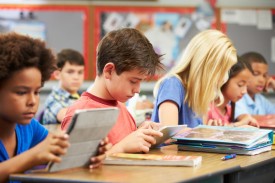 The iPad has made rapid inroads into the K-12 school tech environment – and that doesn’t seem to be a bad thing. As we saw in a recent blog post, when students work with iPads at school, the result can be increased student engagement, greater collaboration, and heightened perseverance – all great things for learners. And less “techie” teachers need not fear – students can teach each other what they need to know. Asking for and giving help provides valuable oral language practice and can build learner confidence.
The iPad has made rapid inroads into the K-12 school tech environment – and that doesn’t seem to be a bad thing. As we saw in a recent blog post, when students work with iPads at school, the result can be increased student engagement, greater collaboration, and heightened perseverance – all great things for learners. And less “techie” teachers need not fear – students can teach each other what they need to know. Asking for and giving help provides valuable oral language practice and can build learner confidence.
So what are some ways that teachers can use iPads in the classroom, besides having them work on literacy apps during tech time? One great option is to assign projects that require learners to construct their own multimedia presentations using free apps that come pre-installed on the iPad.
Most learners love working on multimedia projects to share with teachers and classmates, and projects like these have a lot to offer. As they actively combine still imagery, video, audio and text to communicate and illustrate concepts or ideas, students are able to:
- Learn at their own level and speed
- Practice language skills and synthesize learning
- Connect academic learning to the bigger picture of life outside the classroom
- Express themselves more fully
iPad Project Ideas for Students
Getting students creating with the iPad is as easy as knowing what tools are available and imagining how those tools can be used to support classroom learning. Teachers who aren’t sure where to begin can try one of these ideas, easily adaptable to learners of different ages:
- Plan a Party with Numbers and Keynote
Learners can have a lot of fun and learn a ton planning a party with the Numbers appParty Planner tool. Working in small groups, they can discuss what kind of party to plan. Younger learners might enjoy planning a Valentine’s Day class party or holiday celebration, while older learners might like to plan an Oscar party or presidential inaugural ball. Students gain practice reading and writing as they decide on food, entertainment and guest lists; create to-do lists with dates, tasks and notes; and research local prices (e.g., how much would it cost to rent a jumpy house for the Valentine’s Day party, or tents for the inaugural ball?). They apply math skills as they work to balance their vision against an assigned budget and real-life costs. Learners can create spreadsheets and generate interactive charts with Numbers, then insert the charts into Keynoteto present to the class along with sample menus, photos of food, music samples, videos animations and more.
- Create a Public Service Announcement (PSA) with iMovie
Students begin by studying the elements of a PSA before creating their own. Learners can watch a variety of examples on the SchoolTubeand AdCouncilwebsites and then work individually or in groups to select and research a topic, decide on a message, write the script, select a location for the video shoot, and record and edit the PSA. SchoolTube is also a great place for students and teachers to upload student work to share with the world!
- Create Digital Books with iBooks Author
Authoring an ebook is fun for learners and can feel like a significant achievement. With the help of the iBooks Author app, learners can create ebooks with photos, audio, video, web content (e.g., Twitter or blog feeds), and fully formatted slideshow presentations with animations. Learners can use ebooks to deepen their learning about topics covered in previous assignments, offer study advice to other students, or to explore an area of personal interest. Once created, the ebooks can be distributed via the iBook app available in the Apple App Store.
- Student Stories with iMovie or Garageband
Audio and video are powerful mediums for storytelling. Students can record a video narrative of their family history or their own personal history, or pick a family member to interview. Photos from the family album can be scanned and sprinkled in with the video footage in iMovieto make the past more real and provide a multigenerational perspective. Or, students can also record audio-only versions of family stories using Garagebandfor insertion into a Keynote presentation or ebook.
Setting the Stage
No matter how learners use iPads in school, it’s important to establish and enforce routines for use right out of the gate. Students need to understand check-out and check-in procedures, how to handle and maintain the iPad, whether they may take their assigned iPad out of the classroom, and what counts as appropriate use (e.g., are learners allowed to change settings, download apps, visit social media sites, IM their friends, etc.?). Using the iPad in a structured way benefits both teacher and learner by ensuring that classroom goals and learning needs are met.
As important as structure is, it shouldn’t take the fun out of using the iPad to learn. Fun is part of its appeal. Teachers should let the iPad be different and special, making use of it for activities that can’t be done on paper. Use it for all of the bells and whistles that draw students to it in the first place. Encourage learners to use the camera, sound, video, and internet – and let the learning come to life.
Related reading:
Using Twitter in School: 4 Ways Students and Teachers Can Connect With the World
The iPad® and Student Engagement: Is There a Connection?

